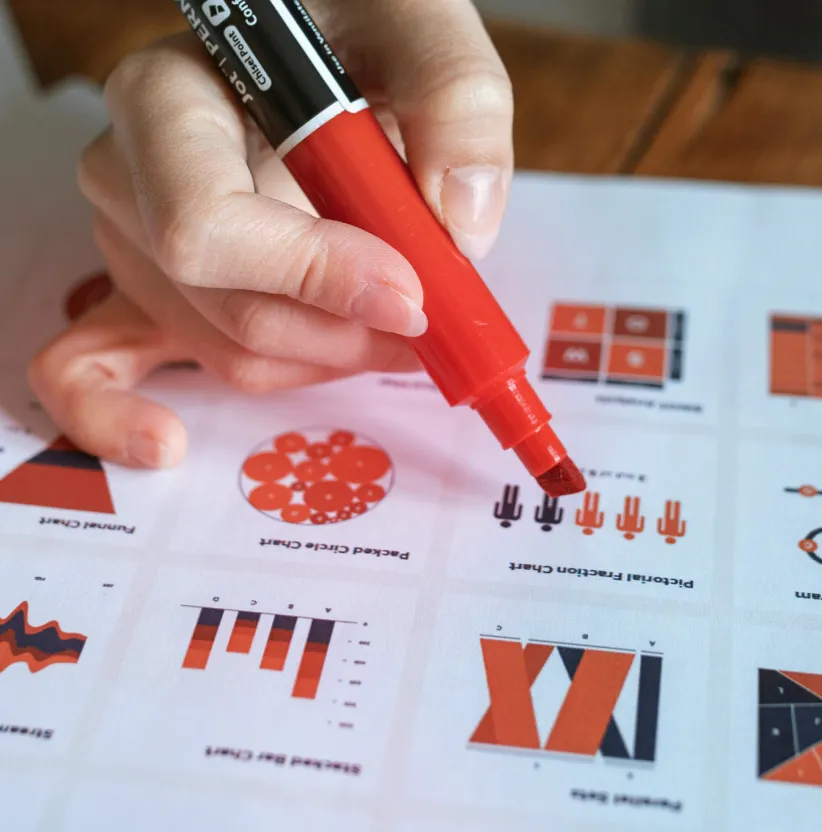New Product Development Steps: Why Your First Product Version Shouldn’t Be Your Last
The product development process can be both exhilarating and daunting. From developing a concept to the final launch, every step you take in the new product development process is crucial in determining the success of your product. But what exactly is the key to innovative product development? Continuous iteration.
The difference between success and failure can come down to knowing when to iterate your product, and when to simply go ahead and launch it. This article will look at the following common markers of an innovative product development cycle, and explain why your first product version shouldn’t be your last:
- The stages of the product development process
- How to identify your target market
- How to determine product viability
- Achieving ‘innovation’
- How to know your product is ready for market
- How Busy Rebel can guide your product development
The New Product Development Process
The product development life cycle can be thought of as a kind of roadmap. This roadmap takes you through the process of turning your ideas into tangible products that resonate with your target market.
There are six distinct stages in the development process of a new product:
1. Discovery and Ideation
The discovery and ideation phase starts the product development process and sets the stage for innovation. The goal during this stage is to spark innovative product ideas and identify market opportunities.
A product is only as good as its data, and by leveraging broad perspectives and diverse data during this idea screening stage, businesses can discover potential opportunities for product development.
Brainstorming sessions, market research, and gathering data and feedback from your target audience help generate a pool of potential product ideas. Organizations should utilize SWOT analysis, design thinking workshops, and technology scouting here to understand their ideas’ strengths and weaknesses better and explore user-focused solutions to design-related issues.
2. Concept Development
Once a variety of ideas have been generated, the concept development stage is ready to begin. In this stage, the product development team will refine and expand upon their ideas and turn them into solid product concepts.
Market research is pivotal in concept development, defining a product’s features, benefits, and value proposition. It also aids in assessing the product’s market potential and feasibility. This process involves gathering user insights to understand target users and validate the product concept.
At this stage, organizations should prioritize User Experience (UX) research. This approach provides qualitative and quantitative data and insights into how users interact with your product. Additionally, aggregated user persona development helps understand users’ needs, experiences, behaviors, and goals. By incorporating ethnographic research and a community-first approach, you can create a product that precisely addresses the needs of your target market and resolves their pain points.
3. Concept Testing, Definition, and Planning
The early stages of product development involve concept testing, where gathering feedback from the target audience and consumers in the target market is critical. This feedback helps businesses understand potential consumers’ interests, perceived value, and purchase intent. By soliciting input at this stage, businesses can identify and address potential concerns or shortcomings before investing significant resources.
During this stage, it is important to define a unique value proposition (UVP) and create a communication strategy. The LTV/CAC ratio should be calculated, and predictive analytics for market trends should be used. Product road-mapping with product-led growth (PLG) and the value proposition canvas are essential to successful product planning.
4. MVP Development
With a strong product concept, the development stage can begin. Here, businesses can turn their product concepts into prototypes or Minimum Viable Products (MVPs). This product development stage involves iterative design, using a prototyping phase to test and refine the product features and functionality, then gathering feedback on the user experience.
Creating an MVP requires prioritizing viability over design, ensuring the idea is aligned with the budget and profitability in the long run. Measuring usability is also important to ensure that the product meets customer needs.
Another key step is creating value with the least effort through value-based product development. A/B testing and feature flagging compare different design variations and test new features, respectively.
The Lean Analytics Cycle is a data-driven framework based on the Lean Startup methodology. It helps test hypotheses, learn from experiments, and continuously iterate the product or service. This, along with Agile product development practices and methods based on the Agile Manifesto’s principles and values, promotes early user testing and feedback loops to continuously collect customer feedback and improve the product.
5. Test Marketing and Prototyping
Test marketing and prototyping are crucial stages in innovative product development. They allow businesses to test and refine their products before they are launched more widely, ultimately increasing their chances of success in the marketplace.
Test marketing involves conducting limited market trials to assess customer reception and gather feedback, providing businesses with invaluable insight into consumer preferences, market demand, and potential barriers to adoption.
Meanwhile, prototyping and product design refine the product design based on feedback and solve common design issues before product development begins. Usability testing, focus groups, and experience mapping are also used in this phase to gather feedback and improve the user experience.
6. Product Launch and Continuous Improvement
The full-scale development phase involves developing the complete set of product features. Various activities such as tech advancement, agile/scrum methodologies, DevOps practices, and microservices architecture are used to achieve this. These methodologies and practices help ensure the product development process is efficient and effective.
After the product is fully developed, the next step is to launch it into the market. This involves executing a go-to-market strategy, engaging early adopters, monitoring churn rates, predictive launch analytics, and implementing omnichannel marketing strategies. These activities help validate the market and ensure the target audience receives the product well.
Once the product is launched, continuously improving and innovating is important to maintain competitiveness and adapt to user needs and market trends. This involves continuous improvement through user feedback and A/B testing, navigating disruptions, considering quantum computing, and considering sustainability and ethical design principles. By considering these factors, businesses can ensure that their products remain relevant and continue to provide value to their customers.
Identifying Your Target Market: Why It Matters
Identifying your target market is crucial to the success of any product development process. It can help you understand why your audience buys your product, why they choose not to, and their preferences and pain points. By understanding your target market, you can increase the likelihood of your product succeeding in a competitive marketplace.
Effective Strategies for Defining Target Markets
So, how can you predict market trends, clearly understand consumer demographics, and discover unlikely insights into your target audience? The answer is market research. In Phase 2 of the product development process, Market Research and User Insights, you can deeply understand your target users and validate your product concept.
Here are some methodologies to help you define your target market:
User Research
User experience (UX) research is an integral part of the product development process. It involves using different research methods to gather qualitative and quantitative data and insights about how your users interact with your product. You can gain valuable insights into your users’ behaviors, preferences, and needs by conducting user research.
Aggregated User Persona Development
Personas are fictional characters created based on research to represent different user types that might use your product, service, or brand similarly. Creating personas helps you understand your users’ needs, experiences, behaviors, and goals. Developing personas allows you to identify your target market and tailor your product to meet their needs.
Sentiment Analysis
Sentiment analysis is an approach to natural language processing that identifies the emotional tone behind a body of text. By analyzing the sentiment of your target audience, you can gain insights into their opinions about your product and identify areas for improvement.
Ethnographic Research
Ethnographic research helps product managers identify unmet customer needs and potential opportunities to develop new products or services. By observing users in their natural settings, product managers can gain insights into their problems and how they cope with them.
Community-First Approach
A community-first approach is about starting small, inviting a group of early believers, tapping into their desires, and creating a narrative that resonates with them. By using their feedback and validation to create a product that meets their needs and solves their pain points, you establish product fit while building social proof at the same time.
Determining Product Commercialization and Viability
Bringing a product to market is an exciting moment in the product development process. But, before businesses take the leap and launch their product, they must assess its viability.
Factors to Consider for Market Readiness
Several factors should be carefully evaluated to determine if a product is ready for market launch. These include:
- Assessing market demand for the product and competition
- Conducting feasibility studies to evaluate technical and financial viability
- Analyzing potential risks and challenges
- Gathering feedback from target customers through prototype testing and market validation exercises
Product Planning and Commercialization Strategies
Maximizing your product’s success at launch can be helped with detailed and airtight product planning and commercialization strategies.
A well-defined product plan will be your roadmap, guiding each stage of the commercialization process from the initial concept of your product to post-launch marketing and sales.
Commercialization strategies essentially help a company to sell a product successfully and make more money. These strategies are essentially solid ideas about how much to charge for the product, how to get it to customers, how to tell people about it, and how to convince them to buy it.
Achieving Innovation and Product Improvement
One of the most important aspects of the product development process is innovation in idea generation. You need to ensure that your business and products stay ahead of the competition and meet the evolving needs of your consumer base.
Here are some strategies to help ensure innovative solutions during product development:
1. Encourage a Culture of Creativity
Cultivating an environment where creativity thrives is essential for generating as many ideas as possible. This is a vital part of your new product development strategy and should involve encouraging brainstorming sessions, promoting cross-functional collaboration, and rewarding employees for creative thinking.
2. Embrace Customer-Centric Design
Understanding the needs and preferences of potential customers is critical to developing innovative products that resonate with target audiences. Use market research, customer surveys, and user testing to gain insight into customer needs and to inform product development decisions.
3. Invest in Research and Development
Allocating resources to research and development (R&D) efforts during the product development process enables businesses to explore new technologies, experiment with novel concepts, and push the boundaries of innovation. Investing in R&D can lead to the development of breakthrough products that differentiate businesses from competitors.
4. Emphasize Continuous Improvement
Recognizing that innovation is an ongoing process is crucial for driving continuous improvement in product development. In order to have a successful product, you should constantly gather customer feedback, monitor market trends, and iterate and improve product designs to address evolving needs and preferences.
Why Your First Product Version Shouldn't Be Your Last
Deciding when to launch a new product can be a challenging question to answer. While some might argue that it’s best to wait until the product is perfect, the reality is that perfection is often an unattainable goal. Instead, it’s important to recognize when your product is “good enough” to go to market.
While it is true that product development must be iterative, businesses should be able to identify the signs that indicate their product is ready for launch and determine whether to go with product #5 or #100.
Signs Your Product is Ready to Launch
After going through the various stages of product development, it can be challenging to know when your product is ready to launch. However, some key indicators can help determine if your product is ready for market.
- Clear Product Vision: Your product vision must be well-defined, and you must clearly understand the problem it solves and the value it provides to your target audience. Ensure your product aligns with your company’s goals and has a unique selling proposition that differentiates it from competitors.
- Positive Feedback from Target Audience: Customer feedback is critical to product development. Before launching your product, ensure you have gathered sufficient input from your target audience. If the feedback is positive, it’s a good sign that your product is ready to launch.
- Product Meets User Needs: Your product should be designed with the user in mind. It’s essential to ensure that your product meets the needs of your target audience and resolves their pain points. Check if your product provides a seamless and easy user experience.
- Scalability and Sustainability: Your product should be scalable and sustainable in the long term. It’s crucial to ensure that it can adapt to changing market needs and improve over time.
- Budget and Resources: Finally, ensure that you have the necessary budget and resources to launch your product successfully. Also, ensure that you have a well-defined marketing strategy and a plan in place to measure your product’s success.
By considering these indicators, you can determine if your product is ready to launch and increase your chances of success in the market.
A Strategic Approach to Product Development
It is important to embrace the iterative nature of innovative product development rather than view it as a linear progression. Look at each iteration as “product improvement.” Conduct thorough market research, identify your target audience, and prioritize features that align with customer needs and preferences.
Focusing on the Minimum Viable Product (MVP) approach allows businesses to deliver value to customers quickly while gathering valuable feedback for future iterations of their innovative new product.
Balancing Innovation and User Needs
While it can be said that innovation lies at the heart of any successful new product development process, this innovation must also be tempered through detailed market testing and understanding.
Use customer feedback and market trends, and ensure you tweak your product and marketing strategy as you go to maintain the competitive edge. Fostering a culture of continuous improvement within your product development team makes all of this easier.
Busy Rebel MVP Product Design and Development
Developing a new product can be complicated, and having an experienced guide to help you navigate the journey can be invaluable. Busy Rebel offers clients much more than MVP product design and development services. We understand that every business has unique goals, challenges, and visions, so we become your strategic allies, helping you every step of the way.
Do you have questions about the product development process? Are you unsure about how to take your concept from idea to launch? Busy Rebel can help successfully bring your product to market.
By partnering with Busy Rebel, entrepreneurs gain access to:
- Strategic Partnership: Beyond just MVP product software design and development, we become your strategic allies, understanding your business goals, challenges, and vision to build an MVP that’s truly transformative.
- Edge Technologies: We use the latest tech innovations, ensuring your MVP is current and future-proof, ready to adapt and evolve with the ever-changing digital world.
- Dedicated Support and Guidance: From the initial concept to post-launch support, our team is with you every step of the way, offering insights, recommendations, and support.
Final Thoughts
The journey of new product development is an exciting and dynamic process that requires continuous iteration and innovation. While your first product version marks an important milestone, it’s important to recognize that it shouldn’t be your last.
Embracing the iterative nature of product development and knowing when to stop refining and launching your fresh and inventive new product can position it for success in the marketplace.
FAQs
What makes a good MVP?
A good MVP focuses on delivering the core functionality or features that address the target audience’s specific problem or need. It should be simple yet effective, allowing users to experience the product’s value proposition without unnecessary bells and whistles. The key is to gather feedback quickly and iteratively improve the product based on user insights.
How many steps are in the new-product development process?
The new-product development process typically involves several steps, varying depending on the approach and industry. However, a commonly accepted framework includes idea generation, concept development and testing, product development, test marketing, and product launch. Each step is crucial in guiding the product from conception to market introduction.
What comes after the MVP?
After the MVP, businesses refine their product based on user feedback, add new features or functionalities, and expand their user base. Busy Rebel can help guide you through every stage of product development, from concept to launch and beyond, leveraging the latest technologies to build innovative and future-proof products.






